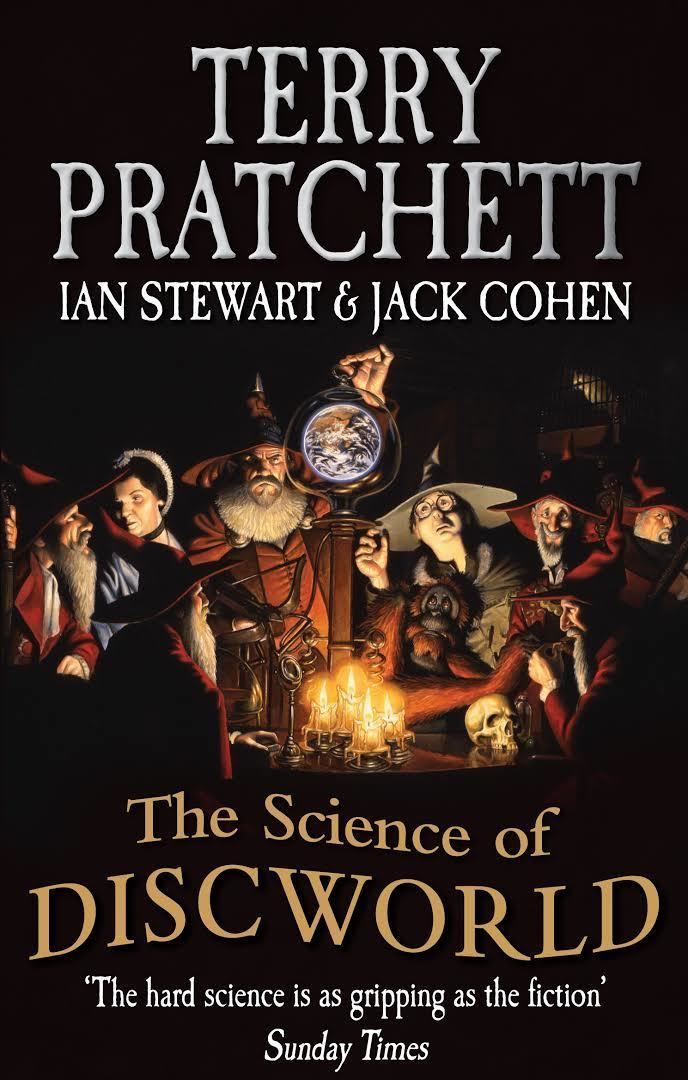7.2 /10 1 Votes7.2
3.3/5 Barnes & Noble ISBN 978-0091865153 | 3.9/5 Goodreads Language English Originally published 1999 | |||||||||||||||||||||||||||||||||
 | ||||||||||||||||||||||||||||||||||
Series Discworld1st science novel Subject History of the worldEvolutionCharactersRincewind, Unseen University StaffLocationsUnseen University, Roundworld Characters Hex, Ponder Stibbons, Adrian Turnipseed, Senior Wrangler, Dean Nominations Hugo Award for Best Related Work Similar Terry Pratchett books, The Science of Discworld books, Fantasy books | ||||||||||||||||||||||||||||||||||
Terry pratchett jack cohen and ian stewart discuss the science of discworld iv judgement day
The Science of Discworld is a 1999 book by novelist Terry Pratchett and popular science writers Ian Stewart and Jack Cohen. Three sequels, The Science of Discworld II: The Globe, The Science of Discworld III: Darwin's Watch, and The Science of Discworld IV: Judgement Day, have been written by the same authors. The book alternates between a typically absurd Discworld story and serious scientific exposition after each chapter.
Contents
- Terry pratchett jack cohen and ian stewart discuss the science of discworld iv judgement day
- The science of discworld with terry pratchett at science gallery dublin
- Plot summary
- Ideas and themes
- References
The purpose of the book is both to entertain and educate. In having fictional sections in which observers from a very different world with a very different set of rules look with confused eyes upon the Earth ("Roundworld"), the authors are able to expand upon things we take for granted, such as planets being round and stars being far away, in a manner which is free of a line of thinking which states "But that's obvious".
The cover of the book, designed by Paul Kidby, is a parody of the 1768 painting "An Experiment on a Bird in the Air Pump" by Joseph Wright of Derby.
The science of discworld with terry pratchett at science gallery dublin
Plot summary
The Discworld part of the book begins when a new experimental power source for the Unseen University is commissioned in the university's squash court. The new "reactor" is capable of splitting the thaum (the basic particle of magic), in homage to the Chicago Pile-1 nuclear reactor, which was housed in a rackets court at the University of Chicago.
However, the wizards' new reactor produces vastly more magical energy than planned and threatens to explode, destroying the University, the Discworld, and the entire universe. The university's thinking engine, Hex, decides to divert all the magic into creating a space containing nothing — no matter, no energy, no reality, and, importantly, no magic. The Dean sticks his fingers in the space and "twiddles" them, inadvertently creating the universe. The wizards soon discover that they can move things around in the universe, using Hex. They call it the Roundworld (the Earth), because in it, matter seems to accrete into balls in space (instead of discs on the backs of turtles). They decide to appoint Rincewind, whom they dragged out of bed in the early hours of the morning, the Egregious Professor of Cruel and Unusual Geography, and send him down (against his will) to investigate this strange world.
The wizards create a series of balls of matter in space, and give one of them a Moon (accidentally). This stabilizes the ball enough that, over a score of millennia (the wizards can skip over vast periods of Roundworld time, allowing them to view the history of the universe in less than a month), blobs of life emerge, ready to begin evolving into more complex forms. The book also features a fictional crab civilization and the dinosaurs (both of which are wiped out by comets/asteroids colliding with the earth), before jumping ahead to when an advanced civilization (presumably humans) has evacuated the earth due to an impending natural disaster.
Ideas and themes
The science centres on the origins of the universe, earth and the beginnings of life, the fiction on the creation of a world (the Earth) in a jar. One of the themes is that most scientific explanations are in reality a good deal more complicated than most of us realize. It is explained that this is because their teachers use Lies-To-Children or, in Ponder Stibbons' case, Lies-To-Wizards.
Even-numbered chapters are self-contained essays that discuss, among others, the following topics:
